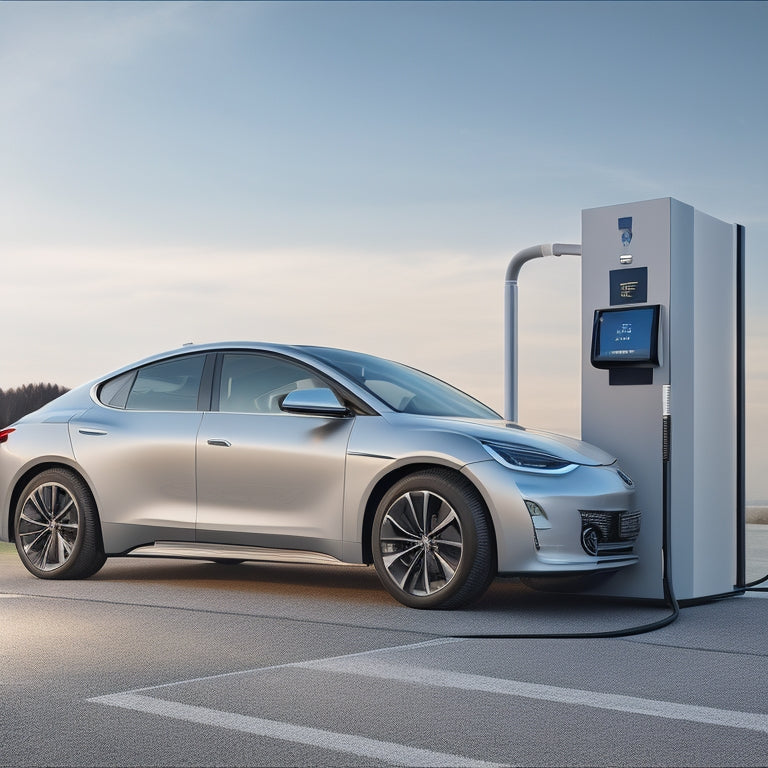
Mastering Electric Vehicle Charging: A Comprehensive Guide
Share
Mastering electric vehicle (EV) charging requires a thorough understanding of the various charging methods, station locations, and optimizing habits. There are three primary charging methods: Level 1, Level 2, and Quick Charging, each with its own installation and speed requirements. Finding stations can be done through app-based services, in-vehicle navigation, or online directories. To optimize charging, it is vital to develop habits such as smart charging during off-peak hours, topping off the battery, and maximizing efficiency. By grasping these concepts, EV owners can maximize convenience, reduce energy expenses, and minimize their environmental footprint, and there's more to explore on this journey to sustainable EV operation.
Key Takeaways
• Understanding the different charging methods, including Level 1, Level 2, and Quick Charging, is crucial for efficient EV ownership.
• Finding charging stations can be done through app-based services, in-vehicle navigation, or online directories like PlugShare and ChargeHub.
• Developing good charging etiquette, such as unplugging when done and not occupying stations unnecessarily, is essential for a positive charging experience.
• Optimizing charging habits, like smart charging during off-peak hours, can save money and reduce strain on the grid.
• Effective charging habits, including topping off the battery, can alleviate battery anxiety and maximize the overall cost and sustainability of EV operation.
Understanding Charging Methods
When it comes to charging an electric vehicle, understanding the different charging methods is essential, as it can greatly impact the overall ownership experience. There are three primary charging methods: Level 1, Level 2, and Quick Charging.
Level 1 charging, the slowest method, uses a standard household outlet and requires no setup or modifications.
Level 2 charging offers faster charging speeds and may require professional installation at home.
Quick Charging, the fastest method, is typically found at dedicated stations and requires a subscription or payment.
Understanding the charging speeds and installation requirements for each method is vital to ensuring a seamless and efficient charging experience.
Finding and Using Stations
Locating charging stations has become increasingly convenient, thanks to the growing network of public charging infrastructure and advanced navigation systems integrated into electric vehicles. To find a charging station, drivers can rely on their vehicle's built-in navigation system, mobile apps, or websites like PlugShare or ChargeHub. It's crucial to practice good charging station etiquette, such as unplugging when finished charging and not occupying the station unnecessarily.
| Charging Solution | Description |
|---|---|
| App-based charging | Utilize apps like ChargePoint or EVgo to find and pay for charging sessions |
| In-vehicle navigation | Many EVs come equipped with built-in charging station locators |
| Online directories | Websites like PlugShare or ChargeHub provide detailed lists of charging stations |
| Roadside assistance | Some manufacturers offer roadside charging assistance for stranded EV drivers |
Optimizing Charging Habits
Effective charging habits are essential to maximizing the efficiency and convenience of electric vehicle ownership, as they can greatly impact the overall cost and sustainability of EV operation. By adopting smart charging habits, EV owners can minimize their environmental footprint and reduce their energy expenses.
One key strategy is to utilize scheduling charges during off-peak hours, when electricity rates are typically lower. This not only saves money but also reduces strain on the grid.
Additionally, topping off the battery whenever possible can alleviate battery anxiety, ensuring a seamless driving experience.
Frequently Asked Questions
Can I Charge My Electric Vehicle in the Rain?
'Yes, you can charge your electric vehicle in the rain, as charging systems are designed with water resistance and safety precautions in place to guarantee safe and reliable charging, even in wet conditions.'
Are Electric Vehicle Charging Cables Universal?
As the electric vehicle landscape unfolds like an intricate tapestry, the question of universality arises. In reality, electric vehicle charging cables are not entirely universal, with varying cable standards and vehicle compatibility rendering a one-size-fits-all solution elusive.
Can I Charge My Electric Vehicle With a Generator?
Yes, you can charge your electric vehicle with a generator, leveraging portable power for remote charging. This off-grid solution enables charging in areas without access to traditional electrical infrastructure, ensuring continued mobility.
Will Charging My Electric Vehicle Increase My Electricity Bill Significantly?
Charging your electric vehicle can increase your electricity bill, but avoiding peak hours and utilizing cost calculation methods, such as time-of-use pricing, can help mitigate the impact and optimize energy costs.
Can I Sell Electricity Back to the Grid From My Electric Vehicle?
Vehicle-to-Grid (V2G) technology enables electric vehicles to supply energy back to the grid, leveraging energy harvesting capabilities. This innovative concept allows EV owners to sell excess energy, offsetting their electricity bills and promoting a sustainable energy ecosystem.
Related Posts
-

Why Choose Cool Roofs in Scorching Climates?
You opt for cool roofs in scorching climates because they enable you to reclaim control over your energy consumption ...
-

Why Choose Solar Composting Toilets for Your Home?
By choosing a solar composting toilet for your home, you'll greatly reduce your environmental impact, slashing your w...
-

10 Grid-Tied Wind Power Systems for Modern Homes
You're looking for a grid-tied wind power system to utilize wind energy for your modern home. Here are ten options to...


